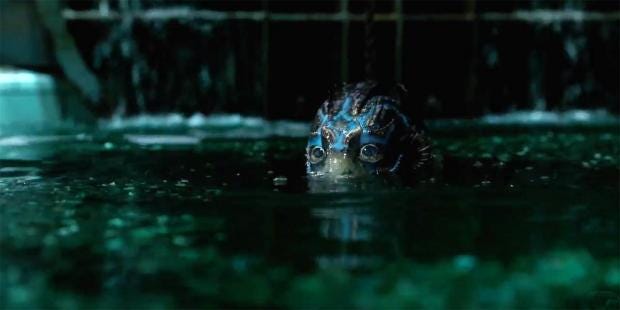
Water has always held a mysterious place in our collective imaginations. It simultaneously acts as a healing, life-giving force while having the power to sweep away all our proud civilizations in one thundering wave. Perhaps no movie has done a better job of embracing the paradoxical nature of water than Guillermo del Toro’s new film, The Shape of Water. It is, after all, a film of many contrasting forces. Man and woman. Land and water. Human and inhuman. Silence and sound. At the center of it all is Elisa Esposito (Sally Hawkins). She lives a quiet life in a small apartment building near Baltimore. By night, she is an overlooked cleaning lady in a government laboratory, reduced to, by most of her work fellows, as the ‘mute woman’. By day, she spends her time delightfully consuming musicals with her neighbor, Giles (Richard Jenkins). Elisa’s life takes a turn when the drab laboratory gains an exotic new asset, an amphibian humanoid closely guarded by the sinister Colonel Richard Strickland (Michael Shannon). Strickland regards the creature as only as an opportunity to spite the Soviets and gain an upper hand in the Space Race, but Elisa’s sympathy soon leads her to a different conclusion.

Del Toro brings the audience into this world with his typical stylistic flair, transforming Baltimore into a land of marshy greens and greys. The color scheme makes the reds and yellows stand out like warning flares in the night. The film is full of these bold colors from the theater sign that lights up Eliza’s apartment building to the stop lights of the streets. Even the occasional factory fire is rendered into a beautiful, distant painting. It is a past that is both nostalgic and fantastical, a thematic approach that is echoed in every environment of the film. For example, the laboratory may be extremely mechanical with its dials and rivets, but it also houses an otherworldly creature from the Amazon. Elisa and her friends are perfectly imperfect for this strange place. Elisa’s inability to speak and Giles’ repressed feelings for other men render them as much abnormalities to this society as her new friend. It is an America, so afraid of Communism, that it demands absolute standardization among its citizens. Thus, the fantasy element of the movie serves to reinforce the real world instead of undermining it. The world around Elisa is already a surreal place, a planet on the path to nuclear self-destruction. It is does not take too much imagination to place a strange fantasy creature in the middle of it all.
Cleverly, del Toro also inserts sound at every opportunity. Elisa, as mentioned repeatedly to ignorant coworkers, is not deaf, but mute. Her life is filled with noisy alarm clocks and crooning records. She even first interacts with the ‘asset’ by carefully tapping the glass of its container. Both Elisa and del Toro understand the importance of sound. It is a powerful, but oft-ignored force, just like her. Elisa’s may lack a voice, but she makes up for it by using sound in many other ways. It is yet another element that makes the world feel expansive and important.

The movie falters, however, when it takes one predictable step too many. Elisa and Strickland were always destined to collide. Their views on what constitutes humanity were simply too divergent, each informed by the lives they have been given. Strickland, privileged by his power and his all-American nuclear family, sees difference also as error. Elisa appreciates and even grows to love those that accept differences instead of judging them. However, these complex and interesting characters are done a disservice by a plot that feels overly familiar, especially when compared to del Toro’s first success, Pan’s Labyrinth. In that film, he mixes environment, character, and plot in just the right amounts. In this one, some elements are vastly more original than others, leading to a final confrontation that feels trapped by convention. It was an attempt to amaze and shock that fell flat. Despite what I consider a rather lackluster ending, I thoroughly enjoyed this film that immersed me (pun intended) into a world that was full of detail, color, and life. The Shape of Water manages to capture the elusive elegance, the seductive power that can only belong to water.

